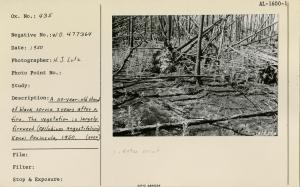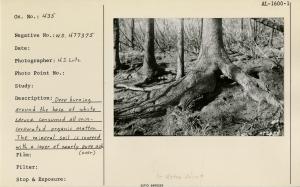| Collection: | Pacific Northwest Research Station, Alaska Image Archive |
| Keywords: |
plant ecology vegetation types ecotypes |
| Location: | Alaska |
| Description: | A quaking aspen-white spruce-black spruce stand approximately 65 years of age. The dominant quaking aspen trees are 6-8" dbh & the spruce trees, which appear in understory, are 2-3 inches dbh & 15-20 feet in height. |
| Date: | 1950 |
| Collection: | Pacific Northwest Research Station, Alaska Image Archive |
| Keywords: |
plant ecology vegetation types ecotypes |
| Location: | Alaska; Interior |
| Description: | An excellent pole stand of Alaska white birch w/an understory of white spruce. |
| Date: | 1950 |
| Collection: | Pacific Northwest Research Station, Alaska Image Archive |
| Keywords: |
forest fires benefits of fire control injurious effects of fire |
| Location: | Alaska; Kenai |
| Description: | A 110-year-old stand of black spruce with occasional quaking aspen, burned in 1947. Note abundant growth of aspen root suckers around fire-killed aspen tree. Kenai Peninsula, 1950. Used as illustration, Fig. 11, pg. 35. USDA Tech Bull 1133, 1956. |
| Date: | 1950 |
| Collection: | Pacific Northwest Research Station, Alaska Image Archive |
| Keywords: |
forest fires benefits of fire control injurious effects of fire |
| Location: | Alaska; Kenai |
| Description: | A 110-year-old stand of black spruce 3 years after a fire. The vegetation is largely fireweed (Epilobium angustifolium). Kenai Peninsula, 1950. Used as illustration, Fig. 9, pg 28. USDA Tech Bull 1133, 1956. |
| Date: | 1950 |
| Collection: | Pacific Northwest Research Station, Alaska Image Archive |
| Keywords: |
plant ecology vegetation types ecotypes |
| Location: | Alaska |
| Description: | A 65-year-old quaking aspen stand with an understory of black spruce and white spruce. The dominants are 4 to 9 inches d.b.h. and 45 to 50 feet tall. The spruce trees in the understory are 2 to 4 inches d.b.h. and 25 to 30 feel tall. Arrows point to aspen. |
| Date: | 1950 |
| Collection: | Pacific Northwest Research Station, Alaska Image Archive |
| Keywords: |
plant ecology vegetation types ecotypes |
| Location: | Alaska; Kenai |
| Description: | A 65-year-old quaking aspen stand. The dominants are 6 to 11 inches d.b.h. and 65 feet tall. A light surface fire killed all understory white spruce in 1947. Kenai Peninsula, 1950. Used as illustration, Fig. 8, Pg. 25 USDA Tech. Bull. 1133 March, 1956. Pl. |
| Date: | 1950 |
| Collection: | Pacific Northwest Research Station, Alaska Image Archive |
| Keywords: |
forest fires benefits of fire control injurious effects of fire |
| Location: | Alaska; Kenai |
| Description: | Windthrown black spruce. 3 years after a surface fire that killed the trees and burned off many of the roots. Fire hazard will be high for many years. Kenai Peninsula, 1950. Used as illustration, Fig. 6, pg. 22 USDA Tech. Bull No. 1133, March, 1956. |
| Date: | 1950 |
| Collection: | Pacific Northwest Research Station, Alaska Image Archive |
| Keywords: |
plant ecology: ecosystems vegetation types, ecotypes |
| Location: | Alaska; Knik Arm; Goose Bay |
| Description: | Dense growth of Alaska paper birch seedlings on mineral soil in the Goose Bay-Knik area. Used as illustration, Fig. 7, Pg.24, USDA Tech. Bull. 1133. 1956. |
| Date: | 1950 |
| Collection: | Pacific Northwest Research Station, Alaska Image Archive |
| Keywords: |
plant ecology: ecosystems vegetation types, ecotypes |
| Location: | Alaska |
| Description: | A climax stand of white spruce about 215 years of age. The dominants are 11-20 inches in diameter and 70-80 feet in height. There has been no fire in this stand during the life of the trees now standing. Used as illustration in Station Paper No. 1, AFRC, 1953. |
| Date: | 1950 |
| Collection: | Pacific Northwest Research Station, Alaska Image Archive |
| Keywords: |
plant ecology: ecosystems vegetation types, ecotypes |
| Location: | Alaska |
| Description: | 150 year old climax white spruce stand on a southwest slope. The dominants are 9 to 16 inches d.b.h. and 70 to 85 feet tall. Used as illustration, Fig. 19, Pg. 64, USDA Tech. Bull No. 1133, March 1956. |
| Date: | 1950 |
| Collection: | Pacific Northwest Research Station, Alaska Image Archive |
| Keywords: |
plant ecology vegetation types, ecotypes |
| Location: | Alaska; Interior |
| Description: | A 55-year-old stand of black spruce. Dominants are 2 to 4 inches d.b.h. and about 15 feet tall. Snags are relicts of 2 fire-killed stands. The last fire killed a pole stand of black spruce and an earlier fire killed a stand of white spruce containing tree... |
| Date: | 1950 |
| Collection: | Pacific Northwest Research Station, Alaska Image Archive |
| Keywords: |
plant ecology vegetation types, ecotypes |
| Location: | Alaska; Interior |
| Description: | A white spruce-Alaska paper birch stand. Approximately 110 years old. Used as illustration, Fig. 13, Pg. 41, USDA Tech. Bull. 1133, 1956. Plate 4, pg. 18, AFRC Station Paper No. 1, Oct 1953. |
| Date: | 1950 |
| Collection: | Pacific Northwest Research Station, Alaska Image Archive |
| Keywords: |
plant ecology vegetation types, ecotypes |
| Location: | Alaska; Interior |
| Description: | A 20-year-old quaking aspen stand. The dominants are 2 to 3 inches d.b.h. and 25 to 30 feet tall. Used as illustration, Fig. 14, Pg. 46, USDA Tech. Bull. 1133. |
| Date: | 1950 |
| Collection: | Pacific Northwest Research Station, Alaska Image Archive |
| Keywords: |
plant ecology vegetation types, ecotypes |
| Location: | Alaska; Interior |
| Description: | A quaking aspen-white spruce stand in which the dominants quaking aspen trees are approximately 115 years of age, 8 to 12 inches d.b.h. and 60 feet tall. The white spruce trees are 5 to 11 inches d.b.h. and 40 to 50 feet tall. Much of the quaking aspen is... |
| Date: | 1950 |
| Collection: | Pacific Northwest Research Station, Alaska Image Archive |
| Keywords: |
forest fires benefits of fire control: injurious effects of fire |
| Location: | Alaska; Interior |
| Description: | Deep burning around the base of white spruce consumed all unincorporated organic matter. The mineral soil discovered with a layer of nearly pure ash. Used as illustration, Fig. 21, page 74, USDA Tech. Bull No. 1133, March 1956. |
| Date: | 1950 |















